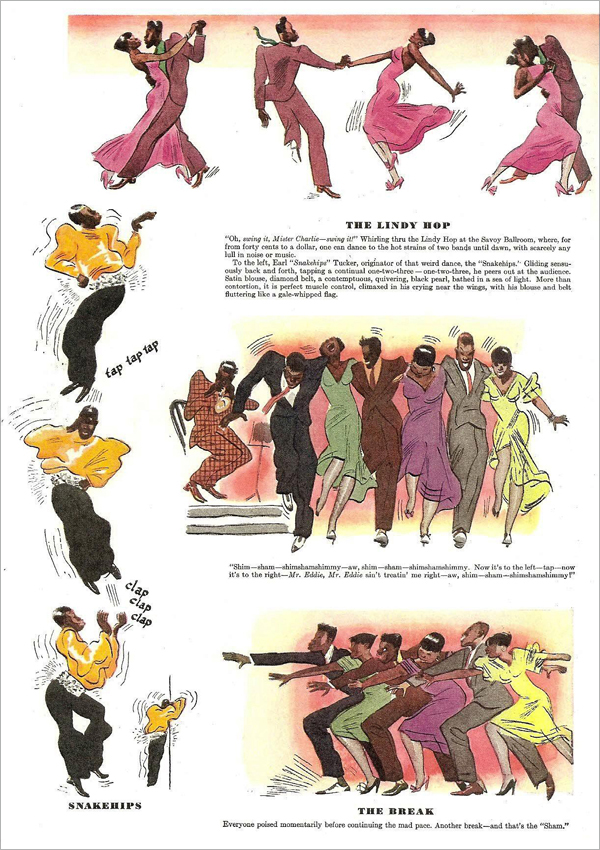Hello again, readers! Today we’ll be taking a miniature tour of jazz and Lindy hop in American visual art.
I was inspired to explore the topic after coming across some stunning images by the early cartoonist E. Simms Campbell, who created several prints and watercolors of 1930s Harlemculture. I figured other swing dancers might enjoy his illustrations, so here they are—plus art from several other artists besides.
E. Simms Campbell
The pioneering African American artist and cartoonist Elmer Simms Campbell was best known in his day for his newspaper cartoons and illustrations for Esquire magazine. Few of his many readers knew he was black: he and his publishers took pains to conceal his identity so he could maintain his readership.
Besides his mainstream periodical work, however, he also created several gorgeous homages to Harlem music and dance culture, including this painting from 1939, The Blues.
The Blues, 1939
His Night-Club Map of 1930s Harlem (1932) is a miniature treasure hunt for jazz aficianados. It features iconic images of the Harlem Renaissance, from Lindy hop and the Savoy Ballroom to Bill Bojangles and Cab Calloway, who of course is yodeling his distinctive “HO-DE-HI-DE-HO.”
According to the key, “The only important omission is the location of the various speakeasies but since there are about 500 of them you won’t have much trouble…”
Finally, this watercolor illustration depicts a number of African American social dances, including the Lindy hop, the shim sham and trucking—which used to be its own style of dance, but, like the Charleston, was eventually incorporated into the wider umbrella of swing.
Frank Harmon Myers
The Charleston (1926), Frank Myers.
This 1926 painting of a lively dance hall seems to be a departure from Myers’ usual subjects, which were more often landscapes or portraiture. He is better known for the Monterey Bay seascapes of his later years, where he was a fixture of the California art scene.
Jitterbugs (III), ca. 1941
William H. Johnson
William H. Johnson was an African American artist active from the 1920s to early 1940s. A prolific painter and printmaker, his artistic output included woodcuts, screenprints, and oil paintings influenced by primitivism and Afro-American folk art.
His Jitterbugs series, completed around 1941, depicts dancing couples in a range of different styles and media. I particularly like the angular Modernist one, Jitterbugs IV.
Jitterbugs (II), ca. 1941
Jitterbugs (IV), ca. 1941
Richard Yarde
Savoy, 1988
Can I just take a minute to enthuse about the incredible cultural tool that is the Internet? I had never heard of this artist or this piece before, and I found it by running searches for dance-related terms like “Savoy” and “Lindy hop” in the Smithsonian’s online archives. Isn’t it awesome? At first I thought it was a small shadowbox, but apparently it’s a 10-foot-tall mural.
According to the Smithsonian:
“It is my hope that the mural will serve to help all people remember the important contribution that Afro-American people have made to dance in this country.”
Richard Yarde, dedication brochure, 1989.
Richard Yarde’s Savoy is one of six indoor murals that were commissioned by the General Services Administration’s Art-in-Architecture Program for the Joseph P. Addabbo Federal Building in Jaimaica, New York. This piece depicts African American dancers at the Savoy, a block-long ballroom in Harlem that flourished between 1926 and 1959. One of the dancers shown in this piece is Frank Manning, a major choreographer for the professional dancers and one of the many Savoy dancers who moved to the borough of Queens in the 1940s. Savoy commemorates the importance of improvisation and inventive dancing in the African American community. The completed mural was installed in 1989 and measures 10 feet by 12 feet.
I hope you enjoyed this brief tour of swing-related art in American history. Next time around, we’re going to the movies!
Further Reading
“Insider Histories: Black Cartoonist E. Simms Campbell,” Print Mag.
The Smithsonian American Art Museum Renwick Gallery: online archives










